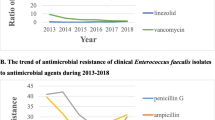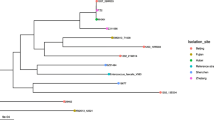Abstract
Vancomycin-resistant enterococci (VRE) are of ever-increasing importance, most notably in high-risk patient populations. Therapy options are often limited for these isolates, and apart from tigecycline and daptomycin, oxazolidinone linezolid is frequently administered. The broad usage of linezolid, however, has driven the emergence of linezolid-resistant VRE strains (LR-VRE), further shortening therapeutic options. Second-generation oxazolidinone tedizolid has the advantage of being active against a specific subset of LR-VRE, i.e. isolates expressing the plasmid-encoded chloramphenicol–florfenicol resistance (cfr) gene. Here we tested tedizolid activity in a collection of 30 LR Enterococcus faecium VRE (MIC range 32–256 mg/l) isolated between 2012 and 2015 from clinical and screening specimens. By pulsed field gel electrophoresis (PFGE) isolates were assigned to 16 clonal lineages. In three cases, linezolid-susceptible progenitor isolates of LR-VRE were isolated, thus demonstrating the de-novo emergence of the linezolid-resistant phenotype. PCR did not detect cfr, cfr(B) or novel oxazolidinone resistance gene optrA in LR-VRE. All isolates, however, carried mutations within the 23S rDNA. Compared to linezolid, tedizolid MICs were lower in all isolates (MIC range 2–32 mg/l), but remained above the FDA tedizolid breakpoint for E. faecalis at 0.5 mg/l. Thus, related to the predominant resistance mechanism, tedizolid is of limited value for treatment of most LR-VRE and represents a therapeutic option only for a limited subset of isolates.
Similar content being viewed by others
References
Arias CA, Murray BE (2012) The rise of the Enterococcus: beyond vancomycin resistance. Nat Rev Microbiol 10(4):266–278
Gastmeier P, Schröder C, Behnke M, Meyer E, Geffers C (2014) Dramatic increase in vancomycin-resistant enterococci in Germany. J Antimicrob Chemother 69(6):1660–1664
Balli EP, Venetis CA, Miyakis S (2014) Systematic review and meta-analysis of linezolid versus daptomycin for treatment of vancomycin-resistant enterococcal bacteremia. Antimicrob Agents Chemother 58(2):734–739
Saager B, Rohde H, Timmerbeil BS, Franke G, Pothmann W, Dahlke J et al (2008) Molecular characterisation of linezolid resistance in two vancomycin-resistant (VanB) Enterococcus faecium isolates using Pyrosequencing. Eur J Clin Microbiol Infect Dis 27(9):873–878
Liu Y, Wang Y, Wu C, Shen Z, Schwarz S, Du XD et al (2012) First report of the multidrug resistance gene cfr in Enterococcus faecalis of animal origin. Antimicrob Agents Chemother 56(3):1650–1654
Liu Y, Wang Y, Schwarz S, Li Y, Shen Z, Zhang Q et al (2013) Transferable multiresistance plasmids carrying cfr in Enterococcus spp. from swine and farm environment. Antimicrob Agents Chemother 57(1):42–48
Deshpande LM, Ashcraft DS, Kahn HP, Pankey G, Jones RN, Farrell DJ et al (2015) Detection of a new cfr-like gene, cfr(B), in Enterococcus faecium isolates recovered from human specimens in the United States as part of the SENTRY Antimicrobial Surveillance Program. Antimicrob Agents Chemother 59(10):6256–6261
Cai J, Wang Y, Schwarz S, Lv H, Li Y, Liao K et al (2015) Enterococcal isolates carrying the novel oxazolidinone resistance gene optrA from hospitals in Zhejiang, Guangdong, and Henan, China, 2010-2014. Clin Microbiol Infect 21(12):1095.e4
Wang Y, Lv Y, Cai J, Schwarz S, Cui L, Hu Z et al (2015) A novel gene, optrA, that confers transferable resistance to oxazolidinones and phenicols and its presence in Enterococcus faecalis and Enterococcus faecium of human and animal origin. J Antimicrob Chemother 70(8):2182–2190
Rybak JM, Roberts K (2015) Tedizolid phosphate: a next-generation oxazolidinone. Infect Dis Ther 4(1):1–14. doi:10.1007/s40121-015-0060-3
Barber KE, Smith JR, Raut A, Rybak MJ (2016) Evaluation of tedizolid against Staphylococcus aureus and enterococci with reduced susceptibility to vancomycin, daptomycin or linezolid. J Antimicrob Chemother 71(1):152–155
Kehrenberg C, Schwarz S (2006) Distribution of florfenicol resistance genes fexA and cfr among chloramphenicol-resistant Staphylococcus isolates. Antimicrob Agents Chemother 50(4):1156–1163
Ruggero KA, Schroeder LK, Schreckenberger PC, Mankin AS, Quinn JP (2003) Nosocomial superinfections due to linezolid-resistant Enterococcus faecalis: evidence for a gene dosage effect on linezolid MICs. Diagn Microbiol Infect Dis 47(3):511–513
Elsner HA, Sobottka I, Feucht HH, Harps E, Haun C, Mack D et al (2000) Nosocomial outbreak of vancomycin-resistant Enterococcus faecium at a German university pediatric hospital. Int J Hyg Environ Health 203(2):147–152
Tenover FC, Arbeit RD, Goering RV, Mickelsen PA, Murray BE, Persing DH et al (1995) Interpreting chromosomal DNA restriction patterns produced by pulsed-field gel electrophoresis: criteria for bacterial strain typing. J Clin Microbiol 33(9):2233–2239
Sahm DF, Deane J, Bien PA, Locke JB, Zuill DE, Shaw KJ et al (2015) Results of the surveillance of Tedizolid activity and resistance program: in vitro susceptibility of gram-positive pathogens collected in 2011 and 2012 from the United States and Europe. Diagn Microbiol Infect Dis 81(2):112–118
Eliopoulos GM, Wennersten CB, Gold HS, Moellering RC Jr (1996) In vitro activities in new oxazolidinone antimicrobial agents against enterococci. Antimicrob Agents Chemother 40(7):1745–1747
Patel R, Rouse MS, Piper KE, Steckelberg JM (1999) In vitro activity of linezolid against vancomycin-resistant enterococci, methicillin-resistant Staphylococcus aureus and penicillin-resistant Streptococcus pneumoniae. Diagn Microbiol Infect Dis 34(2):119–122
Chien JW, Kucia ML, Salata RA (2000) Use of linezolid, an oxazolidinone, in the treatment of multidrug-resistant gram-positive bacterial infections. Clin Infect Dis 30(1):146–151
Gonzales RD, Schreckenberger PC, Graham MB, Kelkar S, DenBesten K, Quinn JP (2001) Infections due to vancomycin-resistant Enterococcus faecium resistant to linezolid. Lancet 357(9263):1179
Prystowsky J, Siddiqui F, Chosay J, Shinabarger DL, Millichap J, Peterson LR et al (2001) Resistance to linezolid: characterization of mutations in rRNA and comparison of their occurrences in vancomycin-resistant enterococci. Antimicrob Agents Chemother 45(7):2154–2156
Dobbs TE, Patel M, Waites KB, Moser SA, Stamm AM, Hoesley CJ (2006) Nosocomial spread of Enterococcus faecium resistant to vancomycin and linezolid in a tertiary care medical center. J Clin Microbiol 44(9):3368–3370
Kainer MA, Devasia RA, Jones TF, Simmons BP, Melton K, Chow S et al (2007) Response to emerging infection leading to outbreak of linezolid-resistant enterococci. Emerg Infect Dis 13(7):1024–1030
Souli M, Sakka V, Galani I, Antoniadou A, Galani L, Siafakas N et al (2009) Colonisation with vancomycin- and linezolid-resistant Enterococcus faecium in a university hospital: molecular epidemiology and risk factor analysis. Int J Antimicrob Agents 33(2):137–142
Herrero IA, Issa NC, Patel R (2002) Nosocomial spread of linezolid-resistant, vancomycin-resistant Enterococcus faecium. N Engl J Med 346(11):867–869
Bourgeois-Nicolaos N, Nguyen TT, Defrance G, Massias L, Alavoine L, Lefort A et al (2014) The emergence of linezolid resistance among Enterococci in intestinal microbiota of treated patients is unrelated to individual pharmacokinetic characteristics. Antimicrob Agents Chemother 58(5):2681–2687
Bourgeois-Nicolaos N, Massias L, Couson B, Butel MJ, Andremont A, Doucet-Populaire F (2007) Dose dependence of emergence of resistance to linezolid in Enterococcus faecalis in vivo. J Infect Dis 195(10):1480–1488
Besier S, Ludwig A, Zander J, Brade V, Wichelhaus TA (2008) Linezolid resistance in Staphylococcus aureus: gene dosage effect, stability, fitness costs, and cross-resistances. Antimicrob Agents Chemother 52(4):1570–1572
Marshall SH, Donskey CJ, Hutton-Thomas R, Salata RA, Rice LB (2002) Gene dosage and linezolid resistance in Enterococcus faecium and Enterococcus faecalis. Antimicrob Agents Chemother 46(10):3334–3336
He T, Shen Y, Schwarz S, Cai J, Lv Y, Li J et al (2016) Genetic environment of the transferable oxazolidinone/phenicol resistance gene optrA in Enterococcus faecalis isolates of human and animal origin. J Antimicrob Chemother. doi:10.1093/jac/dkw016
Zurenko G, Bien P, Bensaci M, Patel HN, Thorne G (2014) Use of linezolid susceptibility test results as a surrogate for the susceptibility of Gram-positive pathogens to tedizolid, a novel oxazolidinone. Ann Clin Microbiol Antimicrob 13:46. doi:10.1186/s12941-014-0046-0.:46-0046
Fiedler S, Bender JK, Klare I, Halbedel S, Grohmann E, Szewzyk U et al (2016) Tigecycline resistance in clinical isolates of Enterococcus faecium is mediated by an upregulation of plasmid-encoded tetracycline determinants tet(L) and tet(M). J Antimicrob Chemother 71(4):871–881
Lellek H, Franke GC, Ruckert C, Wolters M, Wolschke C, Christner M et al (2015) Emergence of daptomycin non-susceptibility in colonizing vancomycin-resistant Enterococcus faecium isolates during daptomycin therapy. Int J Med Microbiol 305(8):902–909
Locke JB, Zurenko GE, Shaw KJ, Bartizal K (2014) Tedizolid for the management of human infections: in vitro characteristics. Clin Infect Dis 58(Suppl 1):S35–S42. doi:10.1093/cid/cit616.:S35-S42
Shaw KJ, Poppe S, Schaadt R, Brown-Driver V, Finn J, Pillar CM et al (2008) In vitro activity of TR-700, the antibacterial moiety of the prodrug TR-701, against linezolid-resistant strains. Antimicrob Agents Chemother 52(12):4442–4447
Author information
Authors and Affiliations
Corresponding author
Ethics declarations
Funding
MSD partially provided reagents used in this study.
Conflict of interest
None to declare.
Ethical approval/informed consent
Not applicable.
Additional information
E.-M. Klupp and A. Both contributed equally to this work.
Rights and permissions
About this article
Cite this article
Klupp, EM., Both, A., Belmar Campos, C. et al. Tedizolid susceptibility in linezolid- and vancomycin-resistant Enterococcus faecium isolates. Eur J Clin Microbiol Infect Dis 35, 1957–1961 (2016). https://doi.org/10.1007/s10096-016-2747-0
Received:
Accepted:
Published:
Issue Date:
DOI: https://doi.org/10.1007/s10096-016-2747-0




